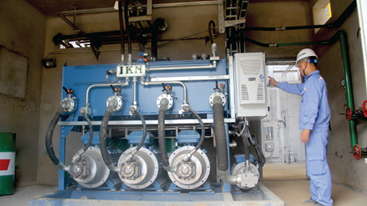Lowering GHG emissions is the collective goal, but those who comply with upcoming changes will also reap countless rewards, including reduced utility bills, increased property value, long-term resilience to climate change, and enhanced occupant comfort.
 Photo: GIRA
Photo: GIRAIf you are the owner of an aging asset, chances are you’ve already begun your energy efficiency journey and are well on your way to a resilient, greener future. But for those still at the starting gates, or looking for a few additional ways to save energy, here are top five recommendations for easy wins to improve the energy efficiency of a building:
1. Lighting equipment
Replacing existing lighting equipment for more efficient lighting is something all owners of aging buildings should do if they haven’t done so already. According to a study by Natural Resources Canada, retrofitting lighting equipment was the most frequent energy efficient renovation upgrade performed by building owners during the study period, and has long been considered a “low hanging fruit” of retrofits.
2. Lighting controls
An even better win, Ochoa says, is to supplement efficient lighting with lighting controls. “One would think replacing efficient lighting would be coupled with controls, however the same NRCan study shows that this measure only came in at fifth place. Occupancy sensors and/or daylighting controls can help manage energy consumption and limit its use to only when needed.”
3. Commissioning
A proper commissioning process for building mechanical, lighting and enclosure systems ensures that the systems operate in line with manufacturers’ recommendations and in accordance with the design intent and owner’s project requirements. This makes it a winning investment on the energy efficiency front.
“Timely filter replacements, adequate temperature set points and other measures ensure the building makes the most of what is available,” explains Ochoa. “This will help the building perform at its most efficient for the service life of its components until the time comes for them to be replaced. Replacements and upgrades are recommended to be done in conjunction with various building functions (e.g., envelope and systems, lighting, etc.) to result in an integrated solution.”
4. Temperature set-points
Another operational win is to lower the temperature set-point used in the make-up air (MUA) unit. According to a B.C. Housing study on energy use in mid- to high-rise MURBs, most energy is used in heating outdoor air for ventilation purposes. The study found that the outdoor air in a large sample of the analyzed buildings was heated to a temperature greater than 20 degrees Celsius, which is higher than needed for corridors and could be reduced to 15 degrees. This adjustment lowered MAU consumption by about 21% and resulted in a building-wide savings of 12%. While Ochoa warns that energy reduction variations will happen depending on climate zone, building type and systems, it will result in a valuable savings.
5. Energy modelling
Last but not least, the “smart, overall win” according to Ochoa, is to engage a building performance engineer to undertake a calibrated energy model. This, she says, will lead to deeper insights into how energy is used in the building and to recommend energy saving strategies that work well operationally or identify elements that need replacement or retrofitting.
“The building performance engineer may be able to provide guidance on existing grants or loans available for the improvements and to undertake simple pay-back calculations,” she says. “They may also be able to undertake thermal comfort assessments to better inform of the compound benefits of any retrofit solution.”
By Reminetwork









.jpg?w=367&h=206&mode=crop) Notice for Contracts award for Support to Industrial Enterprises for Energy Audits and Preparation of Feasibility Studies (Package No. C2.2.4)
04/06/2024
Notice for Contracts award for Support to Industrial Enterprises for Energy Audits and Preparation of Feasibility Studies (Package No. C2.2.4)
04/06/2024
 Training Courses for Energy Managers and Energy Auditors
Training Courses for Energy Managers and Energy Auditors
 Vietnam Energy Outlook Report – Pathway to Net Zero
Vietnam Energy Outlook Report – Pathway to Net Zero
 Long Son Cement saves 30% of electricity consumption thanks to heat recovery
Long Son Cement saves 30% of electricity consumption thanks to heat recovery
 Expression of Interest: C2.1.15: Development of Energy-Efficient Technology Catalogs for the Industrial Sector
Expression of Interest: C2.1.15: Development of Energy-Efficient Technology Catalogs for the Industrial Sector
 Optimizing Compressed Air Systems for Southern Industrial Enterprises
Optimizing Compressed Air Systems for Southern Industrial Enterprises
 The Ministry of Industry and Trade Review the Energy Efficiency and Conservation activities in Lao Cai.
The Ministry of Industry and Trade Review the Energy Efficiency and Conservation activities in Lao Cai.
 EOI Extension: C2.2.2: Review and update for current EE benchmarking for 2 sub-industrial sectors
EOI Extension: C2.2.2: Review and update for current EE benchmarking for 2 sub-industrial sectors